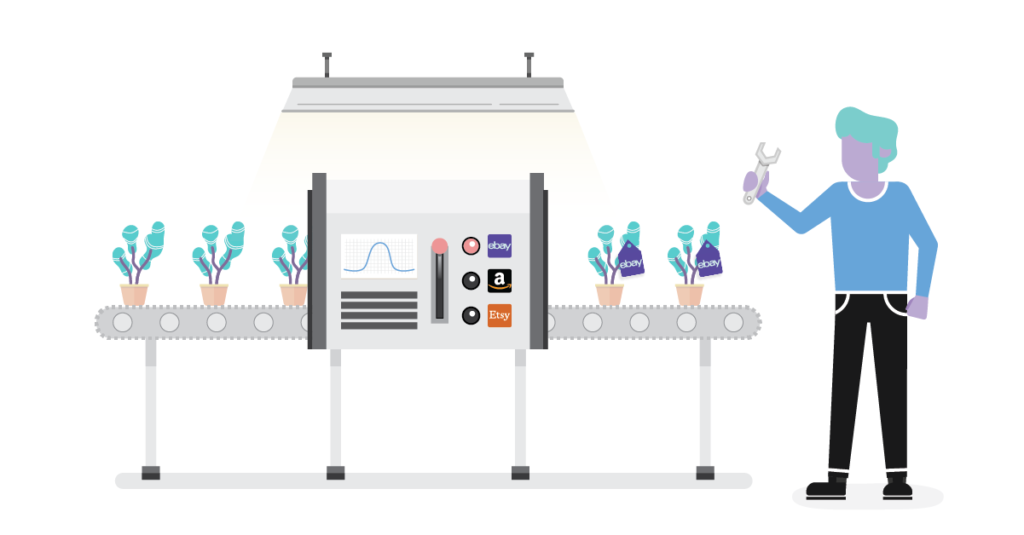At Sellbrite, we’re fortunate to work with amazing sellers of all different shapes and sizes. From startup and brick-to-click to hyper growth phase to established leading brands, we have been fortunate to gain experience and perspective from an extremely wide variety of modern retail businesses.
If there is one thing that has been consistently true, it’s that online sellers are a unique, diverse bunch. Following suit, their specific needs to grow their businesses are just as diverse.
As a small team, we’ve always had more requested of us to build than we’ve had resources to deliver. No doubt, we’re not alone in this struggle – it’s pretty much a fact of life for any product-based tech organization: too much to build, not enough time to build it.
But in ecommerce, and in particular when you’re selling across multiple channels, there are just some things merchants have to have that cannot be justified with a casual “sorry, we haven’t yet added that feature.”
It’s imperative that all your connections with partners and channels be smooth, consistent, and reliable. It’s imperative that you plan for the outages of others, like the marketplace channels, as they ALWAYS happen (and a seller doesn’t want to hear about it, they just want it fixed)! Proactively handling these situations on behalf of merchants before they become a problem and affect their business is critical.
It’s imperative that inventory data is accurate and syncs quickly – there is no room for overselling on today’s customer-first marketplace. It’s imperative that orders are shipped fast and accurately, whether that’s by the merchant, their 3PL, or FBA. It’s imperative that reporting be reliable and accurate, or you’re just undermining the merchant’s best efforts.
But all of these things are now table stakes for any solution that touches inventory. Modern business software needs to be flexible and resilient. Experience with disparate sales channels and their errors/outages/idiosyncrasies should be reflected in the evolution of every successful software solution.
The one thing that is NOT table stakes, though, is also not surprisingly one of the hardest to find in ecommerce software today: great marketplace listing tools. And its in this area, nearly 12 months ago, that the Sellbrite team decided to invest its time, money, and heart… not necessarily in that order… to design a better way to manage sales channels and listings.
Delivering a world class marketplace listing tool
Listings are a seller’s brand ambassadors. They represent everything the seller knows about themselves, their products, their brand, and their customers.
To build a solution that not only helps a business grow, but actually improves how they operate and think about their business, is a pretty rare thing. Lots of solutions help solve a problem. Few solutions truly make businesses better.
The issue is that, as solution providers, we’re susceptible to falling into an all-too-common trap of thinking too much about our solutions (and how best to use them) instead of thinking about the customer’s problems (and how to solve them). As the saying goes, you have to “fall in love with the problem, not the solution”.
So when we set out to redesign our listing tool, our team constantly asked themselves the following question during the design process:
“Why are we making the seller think about this?…”
[gap height=”20″]
Just for background context… this wasn’t the first time we’ve redesigned our marketplace listing tool. Back in 2016, the Sellbrite team made a major technological improvement to our listing functionality in a system we call Templates & Recipes. The functionality allows sellers to dynamically build their listings for each channel, fully customize how each channel appears and what data is used, and manage it all from a single product catalog, so they can power changes everywhere with one-time quick updates. Settings can be saved and tied to a product category, so as brands roll out new versions of their products the listing experience is quick and painless.
It was a huge breakthrough in productivity and value for sellers, but the problem we saw was that our customers now had to learn what Templates were and how they would help, then go about building their Templates, then apply them to their listings appropriately and as needed. Only if we were really lucky (and the seller was really determined) would they get to the most valuable part of the functionality: saving them together as a Recipe to facilitate faster future listing.
What we missed was just how much effort they’d have to spend doing the “prep work”, or learning how to our a software, in order to reach their goal of easily creating and managing listings. Getting to see real value was actually pushed out further into the future than it had been before. Instead of Sellbrite just doing the work for them, or at least masking the work in a familiar context, we were asking even more of our customers in order for them to reach their goals, without even realizing it.
So a year ago, we set out deliver more value from our marketplace listing tool, faster, and without the learning curve, all while preserving the underlying Templates & Recipes engine that we knew had real value. And today, we’re happy to share the fruits of our labor.
The new listing flow involves putting sellers in an environment where they are naturally more comfortable: talking about their products. Instead of having to build tools in Sellbrite to help reach their goals, Sellbrite now builds the tools itself based on their input.
There’s another concept in product management that came into play often: tightly align the user’s “mental model” with the product’s conceptual model. The closer you get, the simpler it will seem.
For us, the conceptual model is reflected in our branding and logo – an octopus. Eight flexible arms controlled from a single brain. We knew Templates were a way of getting closer to the mental model, we just needed a smarter approach so users could focus on their goals, not ours.
The process our sellers enjoy today starts as soon as they connect a channel. Sellbrite automatically builds Default Templates with recommended ‘Best Practice’ settings to be used for listing. The seller doesn’t need to create them, or even know about them.
Action items are limited to just a few steps:
1) Categorize products.
If a seller is coming into Sellbrite with existing listings on a marketplace or online store, 99% of the time this work is already done. When new Sellbrite sellers run our Setup Guide, we build their catalog automatically from existing channels – any marketplace listings have category taxonomy, and the vast majority of Shopify, Bigcommerce, and Woocommerce sellers also categorize the products in their store before employing a tool like Sellbrite.
If a new product or lineup is being added to Sellbrite, it just needs a category.
2) Select items to list.
One of the things our customers consistently tell us they love about Sellbrite is its flexibility. You don’t have to list every product on every channel, and you can control each listing independently as well as in bulk. Choosing items to list is super straightforward, and we have a powerful tagging system for helping to organize your catalog.
3) Map categories to the marketplaces.
This is where the new design really shines. A seller can effectively list their entire catalog in one shot; they just need to tell us where to put their items. By mapping their categories to the marketplaces’ categories, they’re telling us what to do on their behalf while only having to think about their own items. There is no need to learn anything about our software or be told what will happen next. It’s a natural context.
And after this is done, it’s done. A seller doesn’t need to tell us anything else about that category of products ever again. Sellbrite has assigned the Templates to that product category, and it saves those settings and applies them any time a new product is listed under that category. And mappings can easily be adjusted and updated in one spot, sending updates automatically out to the 10s, 100s, or 1000s of listings that fall under that category template.
And those Default Templates we mentioned earlier? Those are linked to the product category as well, so a seller can manage things like pricing, listing titles, descriptions, and more, right from their product catalog with no extra effort.
4) Publish listings to the channels.
Once the mappings are done, the value really shows. Publishing listings from this point on is simply a matter of selecting the products a seller wishes to list and clicking Publish. Our Template functionality doesn’t ever need to make an appearance before the seller, and they never need to visit our Settings page – now, Sellbrite is just doing the work for sellers, automatically, instead of asking them to do the work to learn a piece of software.
5) Repeat steps 2 and 4 only, every time after. And profit… so much profit.
After this one-time setup, our most powerful features are fully configured and ready to be deployed for a seller with just a couple clicks. Managing all listings, efficiently and automatically, from a single product catalog is now a goal that every seller is able to reach in a very short amount of time.
Sellbrite sellers can find this process available now for Amazon and eBay marketplaces. Etsy will be rolling out very soon, and our newer integrations that offer “the old way” of using Templates and Recipes (Walmart and Jet), will be reconfigured soon thereafter.
It’s an exciting time for the product design team at Sellbrite, as we’ve worked closer with our sellers on this redesign, and more closely measured the impact on listing success rates, than we ever have before with any feature. Big thanks goes out to all of our sellers who’ve helped provide feedback on this technology and expedite bringing it to market.
Not yet a Sellbrite seller? Start a 14 day free trial and see why more and more sellers are switching to Sellbrite to master their marketplaces.




